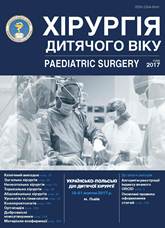Minipercutaneous nephrolithotripsy in children
DOI:
https://doi.org/10.15574/PS.2017.56.94Keywords:
minipercutaneous nephrolithotripsy, urolithiasis, ureterolith, childrenAbstract
Urolithiasis is a multifactorial disease, which based on the interaction of the genotype with the external environment. In recent years, a percutaneous nephrolithotripsy (PCNL), as opposed to extracorporeal shock-wave lithotripsy (ESWL) and moreover «open» surgery, arises at the first plan of treatment in patients with the large and coral renal stones.Objective – to optimize the treatment of urolithiasis in children by implementing minimally invasive technologies.
Material and methods. Clinical material includes 27 patients with urolithiasis aged from 1 to 18 years. All patients diagnosed with unilateral lesions. Stones were located in a pyelocaliceal system (PCS). In one patient the concrements were formed in the left segment of the horseshoe kidney and in one girl in 7 years’ time after the pyeloplasty of the right kidney segment. In the diagnostic algorithm of kidney stone disease, the size and location of the concretions were determined, as well as the renal function and possible concomitant defects or complications.
Results. The technique used by the miniPCNL involves the puncture of PCS and the channel’s dilation under control of the polypositional radioscopy to provide access to kidney stone, the introduction of nephroscope in a channel, crushing of the stone and its fragments extraction. If necessary, when locating concretes in hard-to-reach calyx, the second puncture access to the CPS was used. With the help of miniPCNL we removed all fragments of concretions – «stone free». There were no complications during surgical interventions.
Conclusions. In the case of the large renal stones in children who are resistant to ESWL, the most optimal method of their removal is the contact PCNL. This is especially true while deals with the lower calyx concrete localization, which is anatomically problematic for the independent removal of stone fragments. The advantages of miniPCNL in children are as follows: a minimal surgical trauma and, usually, blood loss; good visualization of intervention subject; sufficient safety of operation and short hospital stay. MiniPCNL can be recommended in children with concomitant urinary tract defects and after previous traditional surgical interventions.
References
Nakonechny AY, Sheremeta RZ, Nakonechny RA, Vivcharivsky TP. (2011). Contact cystolithotripsy in a child after surgical treatment of urinary bladder exstrophy. ACTA MEDICA LEOPOLIENSIA. 17(2): 117–119.
Merinov DS, Pavlov DA, Fatihov RR, Epishov VA, Gurbanov ShSh, Artemov AV. (2013). Minimally invasive percutaneous nephrolithotripsy: delicate and effective tool in the treatment of large kidney stones. 3: 94–99.
Bernikov EV, Mazurenko DA, Lisitsin VN, Vereninov PV. (2013). Current diagnosis and treatment of staghorn kidney stones. Questions of urology and andrology. 2(2): 39.
Katibov MI, Merinov DS, Konstantinova OV, Khnikin FN, Gadjiev GD. (2014). Modern approaches to treatment of large and staghorn stones of anatomical and functional solitary. 1: 60–66.
Lisovyi VМ, Savenkov VІ, Маltsev АV, Levchenko DА. (2017). Standard transcutaneous and ultra-mini transcutaneous nephrolithotripsy in treatment of nephrolithiasis. Klinichna khirurhiia. 3: 27–29.
Lai D, He Y, Dai Y, Li X. (2012). Combined minimally invasive percutaneous nephrolithotomy and retrograde intrarenal surgery for staghorn calculi in patients with solitary kidney. PLoS One. 7(10): Epub e48435.
Türk C, Knoll T, Petrik A et al. (2014). Guidelines on urolithiasis. European Urological Association. Web site. Access mode: http://www.uroweb.org/gls/pdf/22%20Urolithiasis_LR.pdf.
Lahme S, Zimmermanns V. (2008). Minimally invasive PCNL (mini-perc). Alternative treatment modality or replacement of conventional PCNL? Urologe A. 47(5): 563–568. https://doi.org/10.1007/s00120-008-1708-3; PMid:18373077
Nakasato T, Morita J, Ogawa Y. (2015). Evaluation of Hounsfield Units as a predictive factor for the outcome of extracorporeal shock wave lithotripsy and stone composition. Urolithiasis. 43(1): 69–75. https://doi.org/10.1007/s00240-014-0712-x; PMid:25139151
Yamaguchi A, Skolarikos A, Buchholz NP et al. (2011). Operating times and bleeding complications in percutaneous nephrolithotomy: a comparison of tract dilation methods in 5,537 patients in the Clinical Research Office of the Endourological Society Percutaneous Nephrolithotomy Global Study. J Endourol. 25: 933–939. https://doi.org/10.1089/end.2010.0606; PMid:21568697
Tiselius HG. (2003). Epidemiology and medical management of stone disease BJU Int. 91(8): 758–767. https://doi.org/10.1046/j.1464-410X.2003.04208.x; PMid:12709088
Downloads
Issue
Section
License
The policy of the Journal “PAEDIATRIC SURGERY. UKRAINE” is compatible with the vast majority of funders' of open access and self-archiving policies. The journal provides immediate open access route being convinced that everyone – not only scientists - can benefit from research results, and publishes articles exclusively under open access distribution, with a Creative Commons Attribution-Noncommercial 4.0 international license(СС BY-NC).
Authors transfer the copyright to the Journal “PAEDIATRIC SURGERY.UKRAINE” when the manuscript is accepted for publication. Authors declare that this manuscript has not been published nor is under simultaneous consideration for publication elsewhere. After publication, the articles become freely available on-line to the public.
Readers have the right to use, distribute, and reproduce articles in any medium, provided the articles and the journal are properly cited.
The use of published materials for commercial purposes is strongly prohibited.

